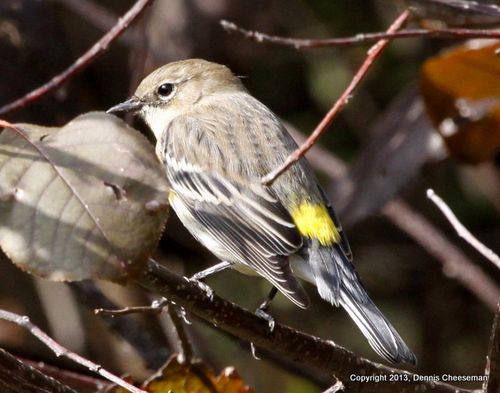
Jim Wright, who maintains this blog, also writes a twice-monthly column for the South Bergenite. His latest is about a Yellow-rumped Warbler banded last fall in Harrier Meadow:
In the past few years, Naturalist Mike Newhouse of the N.J. Meadowlands Commission and his team of volunteers have banded more than 22,000 birds by Harrier Meadow and on the closed Erie Landfill in North Arlington.
The banders capture the birds briefly in mist nets, weigh them and determine their age and sex, then let them fly away.
Although Mike and his crew often see banded songbirds hanging around nearby Harrier Meadow and although they have recaptured some of the same birds over the years, he says that “99.9 percent of the time, a bird is never seen or heard from again.”
That’s why Mike was surprised — and initially excited — late last month when he received a report that one of the 3,400 Yellow-rumped Warblers he has banded over the years was found in Florida.
This particular warbler was a female that Mike’s team briefly captured on Oct. 12 of last year. Almost five months later, on March 15, it was found in the town of Live Oak in Florida — roughly halfway between Jacksonville and Tallahassee, and 1,200 miles from here.
The bird, alas, was dead when Georges Gawinowski found it in his garden.
“I get a lot of birds who come around to drink water — I have a pond,” Gawinowski reported via e-mail. “I did not like to find him dead, poor guy. He may have hit the window or maybe a cat [got him]. He had no mark of visible injury.”
Georges said he reported his find to the bird-banding laboratory at the U.S. Geological Survey because “nature needs our help.”
For Newhouse, the migration of this particular yellow-rump and its eventual demise was a reminder of the perils of migration and the dangers and human-related pitfalls that birds face daily.
That’s one of the main reasons why Newhouse and his crew do their banding-related research — to learn more about the various species of birds that migrate through the Meadowlands.
“Birds face many challenges throughout their lifetime,” says Newhouse. “One of those challenges shouldn’t be finding food during migration.”
That’s why, he says, he and his crew band birds and document their vital statistics — “so we can determine how the habitats in the Meadowlands are being used by migrant birds and are these areas helping them on their journey.”
By keeping track of what species are captured in which kind of habitat, and checking the weight gains of birds that are recaptured, Newhouse and his team can determine the best habitats for any type of bird. In the instance of yellow-rumps, these half-ounce marvels prefer the scrub/shrub habitat in Harrier Meadow Marsh, with lots of insects to eat.
Now is the time that yellow-rumps return to the Meadowlands in large numbers. Next time you see one of these beautiful and abundant warblers, take a moment to appreciate how far it has traveled on those tiny wings.

nice picture, it’s hard to believe one of the birds you banded was founbd in Floriday, that’s cool!
I found a Yellow-rumped Warbler this morning, only got one picture before she left.
Michael
Caught On Camera